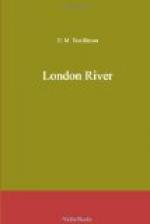It is all very well to say that the names and mere words in this old Register have no more meaning today than a railway time-table of the same date. Hardly to be distinguished in the shadows in some corners of St. Paul’s Cathedral from which night never quite goes, there are certain friendless regimental colours. Few of us know now who bore them, and where, and why; but imagine the deserved fate of one who would allow a brutal word to disturb their dust! They mean nothing, except that men, in a world where it is easy to lose faith, treasure the few tokens of faithfulness, courage, and enterprise proved in their fellows; and so those old staffs, to which cling faded and dusty rags, in a real sense support the Cathedral. Poplar once was a parish whose name was more familiar in Eastern seas and on the coasts of the Americans, and stood for something greater and of more value, than the names of some veritable capital cities. That vista down the East India Dock Road from North Street, past the plane trees which support on a cloud the cupola of Green’s Chapel, to the gateway of the dock which was built for John Company, was what many would remember as essential London who would pass the Mansion House as though it were a dingy and nameless tavern. At the back of that road today, and opposite a church which was a chapel-of-ease to save the crews of the East Indiamen lying off Blackwall the long walk to Stebonhythe Church, is the public library; and within that building are stored, as are the regimental colours in the Cathedral, the houseflags of those very ships my Register helps me to remember—the tokens of fidelity and courage, of a service that was native, and a skill in that service which was traditional to the parish. Tokens that now are dusty and in their night, understood only by the few who also belong to the past.
There is the houseflag of the Cutty Sark, and her sister ships the Dharwar, Blackadder, Coldstream—but one must be careful, and refuse to allow these names to carry one-way. There are so many of them. They are all good. Each can conjure up a picture and a memory. They are like those names one reads in spring in a seed-merchant’s catalogue. They call to be written down, to be sung aloud, to be shared with a friend. But I know the quick jealousy of some old sailor, his pride wounded here by an unjustifiable omission of the ship that was the one above all others for him, is bound to be moved by anything less than a complete reprint here of the Register. How, for example, could I give every name in the fleet of the White Star of Aberdeen? Yet was not each ship, with her green hull and white spars, as moving as a lyric? Is there in London River today a ship as beautiful as the old Thermopylae? There is not. It is impossible. There was the Samuel Plimsoll of that line—now a coal hulk at Gibraltar—which must be named, for she was Captain Simpson’s ship (he was commodore afterwards), the “merry blue-eyed skipper” of Froude’s Oceana, but much more than that, a sage and masterful Scot whose talk was worth a long journey to hear.




